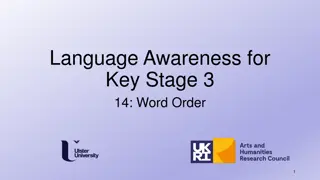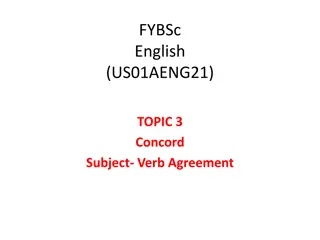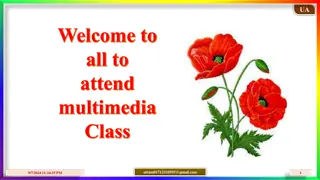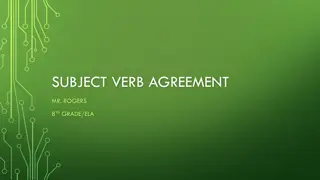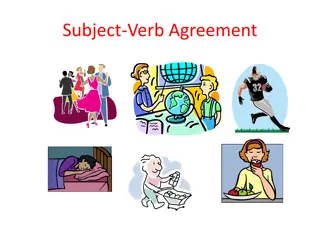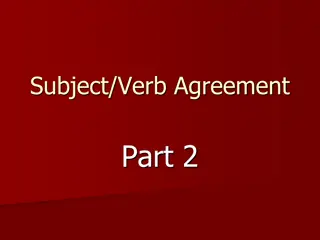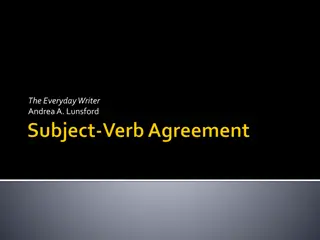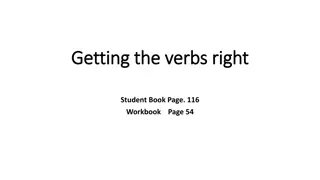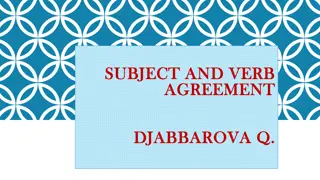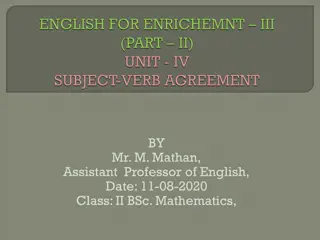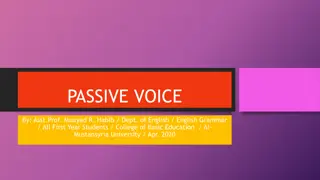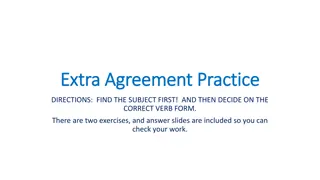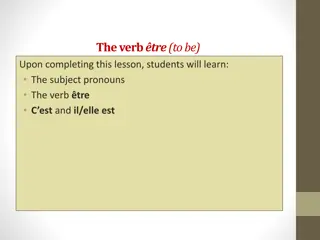Mastering Subject-Verb Agreement for Better Writing
Learn how verbs should agree with their subjects in number, whether singular or plural. Understand the difference between singular and plural verb forms with examples. Discover when to use singular verb forms (ending in "s") with singular subjects like "he," "she," or "it," and when to use plural verb forms without ending in "s" with plural subjects like "they." Improve your writing skills by mastering subject-verb agreement to avoid common mistakes.
Download Presentation

Please find below an Image/Link to download the presentation.
The content on the website is provided AS IS for your information and personal use only. It may not be sold, licensed, or shared on other websites without obtaining consent from the author.If you encounter any issues during the download, it is possible that the publisher has removed the file from their server.
You are allowed to download the files provided on this website for personal or commercial use, subject to the condition that they are used lawfully. All files are the property of their respective owners.
The content on the website is provided AS IS for your information and personal use only. It may not be sold, licensed, or shared on other websites without obtaining consent from the author.
E N D
Presentation Transcript
Writing Lab Agreement-Simple Problems
Why it matters Verbs agree with their subjects in number (singular or plural). Problems arise when writers do not understand the difference between singular verb forms and plural verb forms, or between singular nouns and plural nouns.
Singular Verb Forms End in s Should be used with only singular subjects Singular subjects can be substituted with he, she, or it Examples of singular verb forms: is, has, shows
Plural Verb Forms Do not end in s Should be used with only plural subjects Plural subjects can be substituted with the plural pronoun they Examples of plural verb forms: are, have, show
Verbs with He, She, or It Add an s or es to the verb when you re writing about a he, she, or it. Incorrect: A politician need to be honest to get elected. Correct: A politician (he) needs to be honest to get elected.
Verbs with They Do not add an -s or -es to the verb when you are writing about a they (any group of two or more). Incorrect: These complicated instructions really confuses me. Correct: These complicated instructions (they) really confuse me.
Further Examples of Agreement Incorrect: There are a number of ethnic stereotypes that causes discrimination. Correct: There are a number of ethnic stereotypes that cause discrimination. Incorrect: Much of the support that Mike has come from his classmates. Correct: Much of the support that Mike has comes from his classmates.
Identify Nouns as Singular or Plural Incorrect: As a woman, I am concerned about heart disease and breast cancer being the primary killer of American women. Correct: As a woman, I am concerned about heart disease and breast cancer being the primary killers of American women. Incorrect: Several guest were invited to the Legends Ball. Correct: Several guests were invited to the Legends Ball.
Thats all, folks! This lesson is part of the UWF Writing Lab Grammar Mini-Lesson Series Lessons adapted from Real Good Grammar, Too by Mamie Webb Hixon To find out more, visit the Writing Lab s website where you can take a self-scoring quiz corresponding to this lesson




